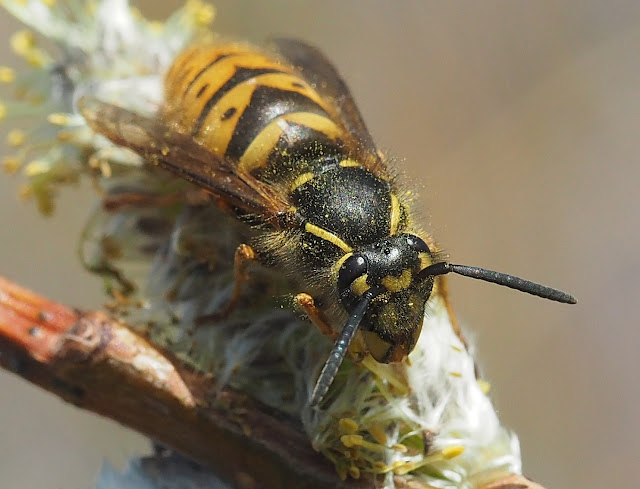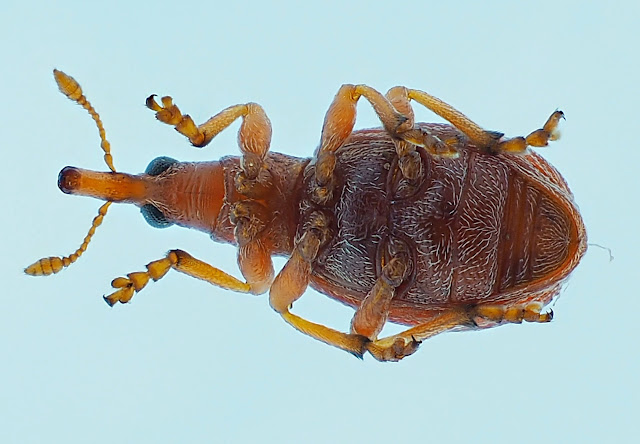There are various reports of Sand Martins and even a Swallow in the last week, but none on the patch as yet. I saw my first Wheatear on 05/04/2023, on the Brough of Birsay. A couple more Wheatears today, at Marwick, by the Choin.
 |
| A fresh Wheatear male is a fabulous thing. |
The hirundines are quite early for Orkney I think, I need to check, the Wheatear about "on time" but seeing my first hoverfly of the year on Tuesday was a bit of a surprise. It turned out to be Syrphus torvus which is not that common here, and more something I find in the autumn.
 |
| Syrphus are a tricky ID but male S. torvus have hairy eyes, you have to look carefully! |
 |
| Syrphus torvus. |
The hoverfly was found on Burray, in the famous Westshore garden, a place with a formidable species list. The willows also contained Bombus terrestris, Bombus lucorum s.l. and a queen wasp which I photographed but wasn't 100% on its ID. A bit of a peruse of eakringbirds website and I decided on Vespula vulgaris rather than the very similar V.germanica.
 |
| Vespula vulgaris, queen. |
That's pretty early for a social wasp here.
Prior to looking in the willows BH and I had headed down to the bottom of the garden, which leads down to the sea over some tussocky grass; perfect! The first tussock was the best one. A pile of weevils tumbled out. Also in there was something I had never seen before, a pseudo-scorpion. Pseudo-scorpions are arachnids, but they are not scorpions. They do have venom, but in the claws, and they are really very small, 3mm or so.
 |
| Neobisium carcinoides (probably, awaiting key to arrive in the post). |
 |
| It looks a bit weird here as a collembola is riding around on its head, pseudscorpion version of a take-away. |
Anyway, back to those weevils. There was a red one, I'd not seen a red one before but knew that should be fairly easy to ID. It was a larger one and initial photos showed it to be an apion.
 |
| Apion frumentarium, note the fungi growing out of the rear of the elytra. |
There are a very few prior records, at 4.1mm the ID was fairly straightforward, the actual feature are the pits on its cheeks, behind the eyes.
I hadn't been that interested in the black weevils, but when I got home I took a close look at them and realised that they were not familiar. Weevils are hard to ID, I find, even with the help of Mark Gurney's excellent online guides. Eventually I was convinced that these were Otiorhynchus desertus which is a nationally scarce (B) species, and new for the county.
 |
| Otiorhynchus desertus, note the "double tooth" on the front femur. |
Searching through the collected specimens at home produced some further treasures. I had no idea what this was...
Also in there were piles of Tachyporus nitidulus (NFM) and a few of the now familiar Tachyporus chrysomelinus. A Stenus clavicornis was surprisingly the only Stenus we found. I think I've found Corticaria umbilicata before, there were three.
 |
| Corticaria umbilicata. |
But a smart Staphy was NFM and a county first.
 |
| Metopsia clypeata, nice. |
There are still a couple of things to sort out, but all in all a very successful outing. Half a day in the field though led to more than a day of microscope and camera work to get everything identified and photographed.
Today I had the day away from the microscope. I had promised one of the museum staff at Stromness my specimen of Australian Spider Beetle, Ptinus tectus, it's a well known problem in museums munching through the displays and archives. The specimen was wanted for training purposes, good to put it to some use. An interesting chat about all sorts of natural history related museum and recording issues was had, although I'm afraid I rather prolonged everyone's day as they were trying to set up a new exhibit. Anyway, I took one beetle and came away with another and two diptera to identify; help will certainly be required with the diptera. I don't visit our museums enough, they are small but full of interest. If you are in Orkney well worth a visit.
I photographed this Bombus terrestris earlier in the week on our new willows. A few years back this species was a real scarcity across the county. The other day there were at least three in our garden and over in Burray I saw one or two as well. All in all these changes are occurring fast, not a good thing I venture.
 |
| Bombus terrestris, a queen, (and passengers). |









No comments:
Post a Comment